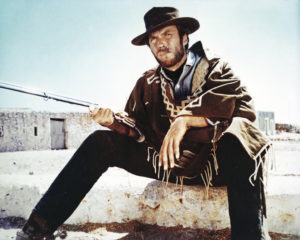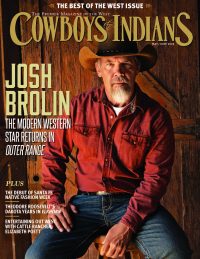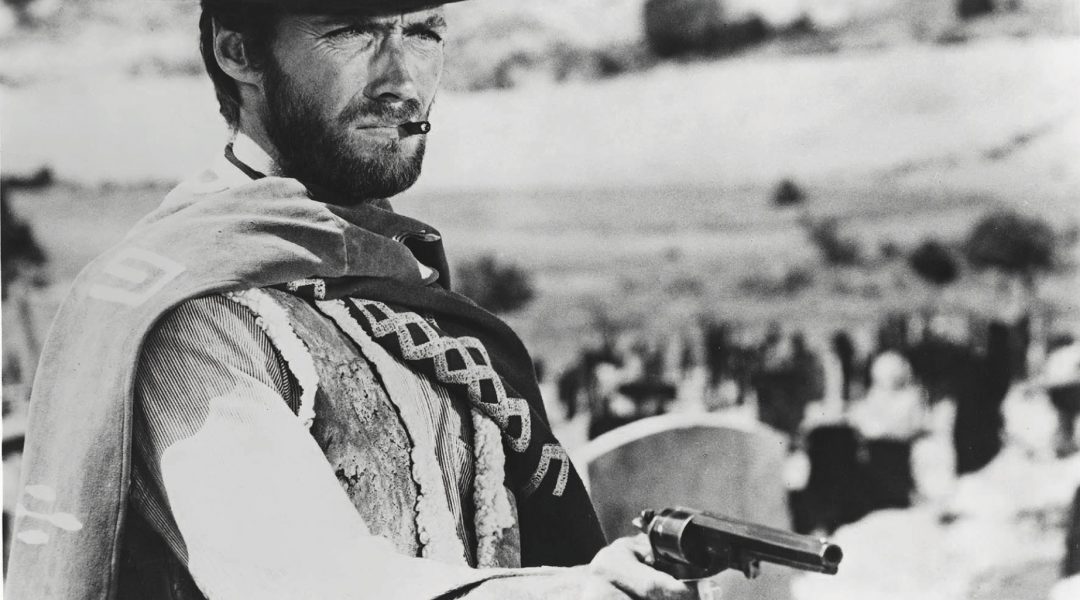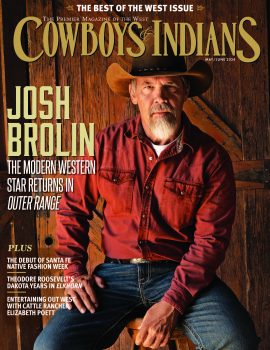The actor gained his first taste of international fame in Sergio Leone’s Dollars trilogy, released in the U.S. 50 years ago.
Looking very much like something the cat dragged in, reconsidered, and dragged outside again, the gritty, grimy stranger rides into the flyspeck border town. He passes a dead man who’s been tied to the saddle of his cantering horse and adorned with a cryptic sign: “Adios, Amigo.” The stranger tips his hat, then rides on.
Draped in a tatty poncho and riding a woefully weary mule, he endures the derisive laughter of four thuggish cowboys who make rude remarks about his humble steed and threadbare attire. They fire their guns into the ground, spooking the mule into a terrified gallop. The stranger manages to dismount only by grabbing a makeshift streetlamp.
In a decrepit cantina, the barkeep brings the stranger up to speed: The town is dominated by two rival gangs, and each side uses hired guns to maintain an uneasy truce. To earn a job, however, an applicant must be a quick draw and a cold killer. The stranger appears intrigued by the employment opportunities.
Back on the street, the stranger walks over to the thuggish cowboys, pausing only to tell an industrious coffin-maker: “Get three coffins ready.” He calmly confronts his tormentors, advising them to apologize to his mule. They respond by laughing. So the stranger flips back his poncho, revealing the six-gun at his side, and the laughter stops. The stranger rasps: “I don’t think it’s nice, you laughin’. You see, my mule don’t like people laughing. He gets the crazy idea you’re laughin’ at him. Now if you apologize, like I know you’re going to, I might convince him that you really didn’t mean it.”
For a long, lingering moment, there is nothing but an ominous silence. Then the thugs start to draw their guns. But not nearly fast enough. The stranger fires repeatedly, hitting each mark. The local sheriff — who just happens to be the employer of the newly deceased — appears from out of nowhere to issue impotent threats. The stranger replies: “If you’re the sheriff, you better get these men in the ground.”
And then, as an aside to the coffin-maker, he adds: “My mistake. Four coffins.”
All of which left movie audiences of the 1960s gaping incredulously and gasping: “Just what the hell kind of western is this?”

Filmed in Spain by an Italian director inspired by a Japanese script, with Italian and German supporting players backing an American TV star in the lead role, A Fistful of Dollars represented an innovative twist in multicultural cross-pollination. Director Sergio Leone took the conventions of traditional sagebrush sagas and pushed them to unprecedented extremes of graphic violence and seriocomic cynicism. By doing so, he more or less invented a new subgenre — the so-called “spaghetti western” — in which old rules did not apply and new attitudes propelled heroes and villains alike.
A Fistful of Dollars stripped away the noble motives and altruistic heroism that had been hallowed hallmarks of the western genre since the silent movie era. The protagonist is a steely-eyed pragmatist who is driven by self-interest, not justice and self-denial, and who gets into trouble only when he impulsively aids a wife and mother commandeered by a bandit chief. He shoots first — and last — and rarely bothers to ask questions afterwards. He comes off as a good guy primarily because the bad guys are much, much worse.
Leone broke all the unwritten laws that had heretofore defined the American-made western — including, most shockingly, the custom that a character’s gun and its lethal impact should never be shown in the same frame.
In 1964, when A Fistful of Dollars first appeared in Leone’s native Italy, and 1967, when it finally appeared in the United States, the wanton slaughter was all the more shocking because so many of the bullets were fired by Clint Eastwood, the personable young star of Rawhide, a then-popular TV western in which the actor played a thoroughly conventional, uncomplicatedly amiable cowboy. Fistful — along with its two more ambitious sequels, For a Few Dollars More (1965) and The Good, the Bad and the Ugly (1966) — turned Eastwood into an international star through the simple expedient of transforming Mr. Nice Guy into a down-and-dirty antihero who would become known throughout the world as The Man With No Name. Several other actors — including Steve Reeves, Edd Byrnes, John Phillip Law, Alex Cord, and — no kidding! — Elvis Presley (in 1969’s Charro!) would follow in Eastwood’s hoofprints, attempting similar image makeovers during the heyday of spaghetti westerns. But only Lee Van Cleef — who costarred in For a Few Dollars More and The Good, the Bad and the Ugly — enjoyed anywhere remotely near the same level of success.
So it’s all the more ironic that Eastwood was not Leone’s first choice, or even the fifth, to play the starring role in a screenplay originally titled The Magnificent Stranger. James Coburn, Henry Fonda, Charles Bronson, Steve Reeves, and Eric Fleming (Eastwood’s costar on Rawhide) were among the actors who were offered the part — but passed because of Leone’s lowball salary offer of $15,000. In his 2009 book American Rebel: The Life of Clint Eastwood, biographer Marc Eliot credits Claudia Sartori, a Rome-based agent with the William Morris Agency, with suggesting Eastwood to Leone and his producers. To make her case, she showed them “Incident of the Black Sheep,” a 1961 episode of Rawhide. The case got made.
More than 20 years later, Leone told biographer Christopher Frayling: “What fascinated me about Clint above all was his external appearance and his own character. In ‘Incident of the Black Sheep,’ Clint didn’t speak much ... but I noticed the lazy, laid-back way he just came on and effortlessly stole every single scene from Eric Fleming.
“When we were working together, he was like a snake, forever taking a nap 500 feet away, wrapped up in his coils, asleep in the back of the car. Then he’d open his coils out, unfold, and stretch. ... When you mix that with the blast and velocity of the gunshots, you have the essential contrast that he gave us.”
For his part, Eastwood was at a point in his career when $15,000 — and the opportunity to visit Europe for the first time — seemed very tempting, and it didn’t hurt that he’d be able to fit the 11-week shoot into his break between seasons of Rawhide. Better still, once production began on location in Spain, Eastwood found Leone to be a confident yet flexible collaborator. The director readily accepted his suggestion to greatly decrease the amount of dialogue he would speak in order to seem more mysterious, even iconic. (“Thus,” Frayling wrote, “Eastwood became one of the very few actors in film history to fight for fewer lines.”) There was a method to his seeming madness: He thought less dialogue, less explanation, would make his character even more of an antihero. “More of a guy,” Eastwood said later, “who was a gunman out for his own well-being, placed himself first, and didn’t get involved in other people’s problems unless it was to his benefit.”
As for being laid-back and snakelike, well, Eastwood admits: “Italian actors come from the hellzapoppin’ school of drama. To get my effect, I stayed impassive — and I guess they thought I wasn’t acting. All except Leone, who knew what I was doing.”
In Eastwood’s view, Fistful “changed the style, the approach to westerns in [Hollywood]. They ‘operacized’ them, if there’s such a word. They made the violence and the shooting aspect a little more larger than life, and they had great music and new types of scores.”
Indeed, throughout all three films in what has become known as Leone’s Dollars trilogy, you see self-consciously ritualized gunfights that intercut immense wide shots of wary antagonists and intense close-ups of their squinty eyes. Everything is overlaid with Ennio Morricone’s alternately twangy and thunderous music, and protracted by pauses sufficiently pregnant to produce quintuplets.
It should be noted, however, that 50 years ago, when all three films were released within months of each other in the United States, many film critics — and quite a few devotees of traditional westerns — found Leone’s spaghetti westerns to be thoroughly unappetizing. One of the most influential movie reviewers in America, Judith Crist of the New York World Journal Tribune and NBC’s Today show, savagely panned A Fistful of Dollars as a “cheapjack production” that “misses both awfulness and mediocrity: It is pure manufacture.” A few months later, Crist was even more incensed by For a Few Dollars More: “A treat for necrophiliacs. The rest of us can get our kicks for free at the butcher store.” Bosley Crowther of The New York Times chimed in: “Mr. Leone piles violence upon violence and charges the screen with hideous fantasies of sudden death.” The Good, the Bad and the Ugly was better received by some critics —including such notables as Roger Ebert of the Chicago Sun-Times and Andrew Sarris of the Village Voice — but Arthur Knight of Saturday Review wrote for the majority when he described the film as “crammed with sadism and a distaste for human values that would make the ordinary misanthrope seem like Pollyanna.”
Even so, the only review that ever seriously rattled Leone was an appraisal by famed Japanese filmmaker Akira Kurosawa, director of Yojimbo, the internationally acclaimed 1961 drama about a wily 19th-century ronin (masterless samurai) played by Toshio Mifune who wanders into a village controlled by contending criminal gangs and plays the opposing groups against each other for fun and profit. (Yes, this was the movie Kevin Costner took Whitney Houston to see in 1992’s The Bodyguard.) Leone, ahem, borrowed freely from Kurosawa’s film while crafting the scenario for A Fistful of Dollars. In fact, he borrowed so much that after Kurosawa viewed Leone’s spaghetti western, he famously dashed off a letter that began: “Signor Leone — I have just had the chance to see your film. It is a very fine film but it is my film. Since Japan is a signatory of the Berne Convention on international copyright, you must pay me.”
Leone mounted a game defense — at one point, he and his attorneys insisted that A Fistful of Dollars actually was inspired by Red Harvest, Dashiell Hammett’s classic 1929 novel about an unnamed detective (identified only as The Continental Op) caught between competing gangs. (Some film historians have theorized that Kurosawa himself drew from the same source material.) After more than two years of protracted legal squabbling, however, Leone agreed to an out-of-court settlement with Kurosawa — thereby clearing the way for United Artists to finally release the entire Dollars trilogy in the United States in 1967.
But a funny thing happened to Eastwood’s sharpshooting, cheroot-chewing gunfighter on his way to America: He kinda-sorta lost his identity.
The Man With No Name actually had a name — three names, actually — when the trilogy first appeared in European cinemas. Listen closely, and you’ll hear him addressed variously as Joe (Fistful), Monco (For a Few Dollars More), and Joe or “Blondie” (The Good, the Bad and the Ugly). But the advertising team at United Artists chose to pique interest in the enigmatic antihero — and wound up playing a key role in the creation of a mythos — by dubbing him The Man With No Name in trailers, posters and newspaper ads when the studio opened A Fistful of Dollars at theaters and drive-ins everywhere. (“This is the man with no name. In his own way he is, perhaps, the most dangerous man who ever lived!”) UA reinforced the brand while promoting For a Few Dollars More, which had Eastwood’s character in an uneasy alliance with a rival bounty hunter played by Lee Van Cleef: “The man with no name is back... The man in black is waiting! As if one wasn’t enough ... as if death needed a double!” By the time The Good, the Bad and the Ugly had its U.S. premiere at the end of 1967, there was no need for repetition: The no-name moniker already was firmly, and immutably, established.
Leone’s later films — most notably, his magnificent Once Upon a Time in the West (1968) — display even greater degrees of operatic flamboyance. But his “Man With No Name” films have remained his most significant and enduringly influential legacy. Originally derided in some circles as blood-soaked pastiches and genre-defiling follies — the term “spaghetti western” originally was coined as a dismissive put-down — they long ago attained respectability for their own considerable merits and for inspiring such action filmmakers as John Carpenter, Sam Peckinpah, John Woo, Walter Hill, George Lucas, Guy Ritchie, and Robert Rodriguez. (Rodriguez admits that Once Upon a Time in Mexico [2003], the follow-up to his El Mariachi [1992] and Desperado [1995], completed his own version of a “spaghetti western” trilogy.) And even though Clint Eastwood’s relationship with Leone was strained after he passed on participating in two later Leone films, Once Upon a Time in the West and 1971’s Duck, You Sucker, he openly acknowledged Leone’s influence on some of his own directorial efforts, including High Plains Drifter (1973) and The Outlaw Josey Wales (1976). He dedicated his 1992 Oscar-winning western Unforgiven to two of his mentors, Don Siegel — who directed him in Dirty Harry, The Beguiled, and four other films — and Leone.
Quentin Tarantino, not merely a fan but a full-bore fanatic when it comes to Sergio Leone, once described The Good, the Bad and the Ugly as nothing less than “the greatest achievement in the history of cinema,” and has paid tribute to the filmmaker he credits as a mentor in many of his own films, especially — but by no means exclusively — Django Unchained (2012) and The Hateful Eight (2015).
Even now, 50 years after the U.S. release of the Dollars trilogy, Christopher Frayling notes in his book Sergio Leone: Something to Do With Death, “Leone’s images of showdowns and duels are still in the pantheon of visual clichés. Like Janet Leigh in the shower, Judy Garland on the Yellow Brick Road, Humphrey Bogart at the airport [in Casablanca] ... they are instantly recognizable, and can register in seconds. The French philosopher Jean Baudrilland called Sergio Leone ‘the first post-modernist director’ — the first to understand the hall of mirrors within the contemporary ‘culture of quotations.’ Thus, it is appropriate — necessary, even — that his work should have been since reflected by so many others.”
And if it seems odd, if not absurd, for a French philosopher to wax philosophical about the influence of spaghetti westerns, consider: Leone — much like Akira Kurosawa — readily acknowledged being influenced by arguably the greatest of all American directors of westerns, John Ford. Sergio Leone passed away in 1989, at age 60. And yet: A man may die, but his movies are forever in the present tense.
In His Own Words
Earlier this year, Clint Eastwood held court at the Cannes Film Festival, appearing at a 25th anniversary screening of his Oscar-winning Unforgiven and participating in a public interview session focused on his life and career. During the latter event, questions posed by noted Los Angeles Times film critic Kenneth Turan prompted Eastwood to look back at the spaghetti westerns that transformed him from working actor to international superstar. Here’s what he had to say.
“I just kind of stumbled through the ’50s, doing bit parts and small parts here and there. Some of them on live TV. Some of them on filmed TV. Once in a while, bit parts in the movies. At the end of the ’50s, in 1959, I got a test for a CBS hour show called Rawhide and I got the job. Then I was employed, and actually making a living as an actor, and that was a dream for me. I went for about six years.
By that time, I had an agent. Before that, I had a hard time finding one, which was OK, I guess. But he asked me if I wanted to go to Italy and make a western, a remake of a Japanese film. I said, “No, I really don’t. I’m doing a western now and it’s on TV every week, and we have a little hiatus. I’d just like to have a few days off and go fishing or something.”
But they asked me to read the script as a favor to the head of the William Morris Agency in Rome. I thought, “This is going to be a piece of crap.” But when I read it, I said, “Hey, this is Yojimbo.” See, I was big fan of [Akira] Kurosawa’s Yojimbo. At the time I saw it, I thought, “That would make a great western, but nobody would have the nerve enough to do it,” as it was so wild. I thought, Gee, maybe I should do this. I’ve never been to Italy. I’ve never been to Spain, where they did a lot of the filming.
So I went over there and it was a very small picture. It was made for $200,000, but it was good. Then I went back and did the other two pictures. ... I did [Fistful of Dollars], and then the next year, by that time, [Sergio Leone] had more money to put into productions. I made [For a Few Dollars More and The Good, the Bad and the Ugly], which were fantasy westerns. They were more operatic westerns than the others we grew up with, but very stylized, and Sergio was great for picking faces. Just looking at things a little different. ...
Sergio was a very interesting character. He had a different way of looking at the size and scope of films. I learned a lot from him.”
From the August/September 2017 issue.













